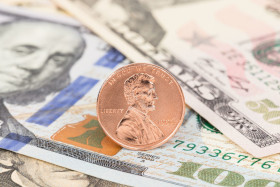The US dollar is mixed against a basket of currencies towards the end of the trading week. The greenback is making sense of an influx of economic data that paints an interesting portrait of the country: a slowing economy, but a solid labor market.
On Thursday, the Bureau of Economic Analysis (BEA) revised its fourth-quarter gross domestic product (GDP) figures. The US government found that the national economy advanced at a slower pace in the October-to-December period, from 2.6% to 2.2%. The report cited softer consumer spending and weaker business investment as the major contributors.
Consumer spending fell from 2.8% to 2.5%, business fixed investment declined from 3.9% to 3.1%, the increase in the value of inventories remained the same at $96.8 billion. Business profits dipped 0.4% to 7.7%, while State and local spending tumbled 1.3%, up from 0.3%. Exports rose from 2.6% to 2.8%, while the increase in imports was cut from 2.7% to 2%.
The personal consumption expenditure (PCE) index was flat at 1.5%.
According to the National Association of Realtors, the index of pending home sales tumbled 1% in February, following a revised 4.3% jump in January. The 12-month gauge plunged 5% from the previous year, following a 3.3% annual decline in the prior year.
New Labor Department data found the number of Americans filing applications for unemployment benefits dropped last week after the market had penciled in an increase. For the week ending March 23, initial claims for state joblessness slipped 5,000 to a seasonally-adjusted 211,000. The median estimate was an increase to 225,000.
The Federal Reserve Bank of Kansas City published its monthly manufacturing survey and found that manufacturing activity had risen in March. The Tenth District Manufacturing Surveyâs composite index, considering several factors like employment and product, was 10 for March, up from one in the previous month â anything above zero shows expansion.
Factories had increased production of durable and non-durable products, including food, wood, paper, and printing manufacturing.
The survey also noted that 48% of US manufacturers said they anticipate additional spending on new plant and equipment within the next six to 12 months.
Factories in the region reported an uptick in growth in March, following three straight months in which the pace of growth slowed. Plans for both hiring and capital spending picked up.
The US Dollar Index climbed 0.28% to 97.22, and it is poised to record a modest weekly gain of about 1%.
The USD/CAD currency pair surged 0.23% to 1.3443, from an opening of 1.3413, at 19:51 GMT on Thursday. The EUR/CAD tumbled 0.19% to 1.1223, from an opening of 1.1246.
If you have any questions, comments, or opinions regarding the US Dollar, feel free to post them using the commentary form below.
